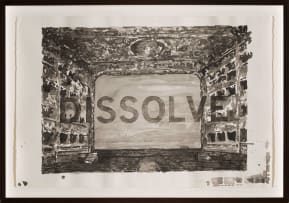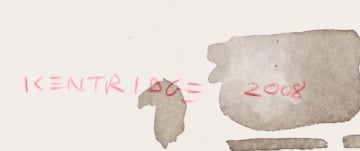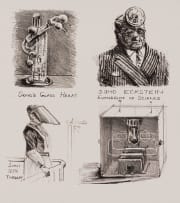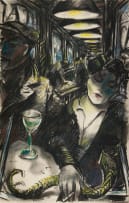Johannesburg Auction Week
Live Virtual Auction, 16 - 17 May 2022
Evening Sale
About this Item
signed and dated 2008
Notes
The proscenium arch of the theatre stage has occupied William Kentridge since he was a drama student in Paris in the early 1980s. Its most productive flowering was his conceptualising of the production of Mozart's The Magic Flute opera in 2005. The arch also dominates the picture plane in the present lot. Ambiguity is evident in that the large central white area could either be the back wall of the stage, or a white fire screen in front of it. Regardless, both surfaces are ideal for projecting various sequences of moving images to tell a story, as Kentridge frequently does in his stop-frame animation video artworks. Many similar drawings done with ink washes are to be found in Learning the Flute, Preparing the Flute and in Flute itself, the various projects, prints and publications in which Kentridge visualised his thoughts about the opera. As a matter of course he visited the Théâtre Royal de la Monnaie in Brussels, where the opera was first performed, studying stage craft and setting, before his own productions appeared in New York and Johannesburg. In many artworks he fills the empty stage with Egyptian architectural elements and Masonic structures, implicated in Mozart's opera, including mastaba-shaped pyramids, secret chambers, hallowed hallways and endless colonnades, as well as scenes from dark woods.
Kentridge frequently experiments with the notion of the stage as subject in his work. The Black Box/Chambre Noir with its phenomenally complex mechanisms of scene changes is a good example. So is the anatomy theatre setting he uses in Il Retorno d'Ulisse. At a grand scale, the embankment along the Tiber River in Rome was integral to the performance of Triumphs and Laments, and more intimately, his studio at home serves as the platform for many of his performance pieces and films.
Words, or 'rubrics' as Kentridge calls them, appear frequently in the artist's work, especially in his later series, including the recent Waiting for the Sybil (2020). The dominant aspect of the work in the present lot is the bold word 'Dissolve' written prominently across the picture plane. It signals a fade-out, or an ending, and Kentridge often uses similar words such as 'Finis' or 'End' to conclude his videos, in the manner of early 'moving pictures' in the history of film. The word also references Kentridge's characteristic working method of drawing, erasing and redrawing for his particular style of stop-frame animation. The prefix of the word, 'dis' recedes, and the root, 'solve', stands out against the white background, suggesting perhaps not only an ending, but also the solution to a problem or making space for a new problem with which to grapple.












